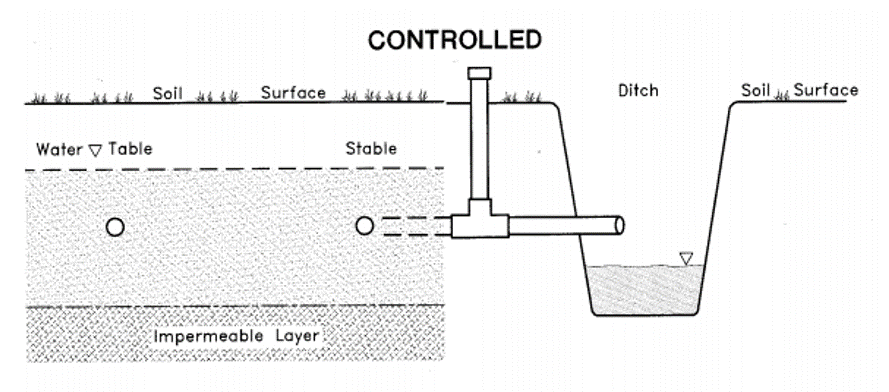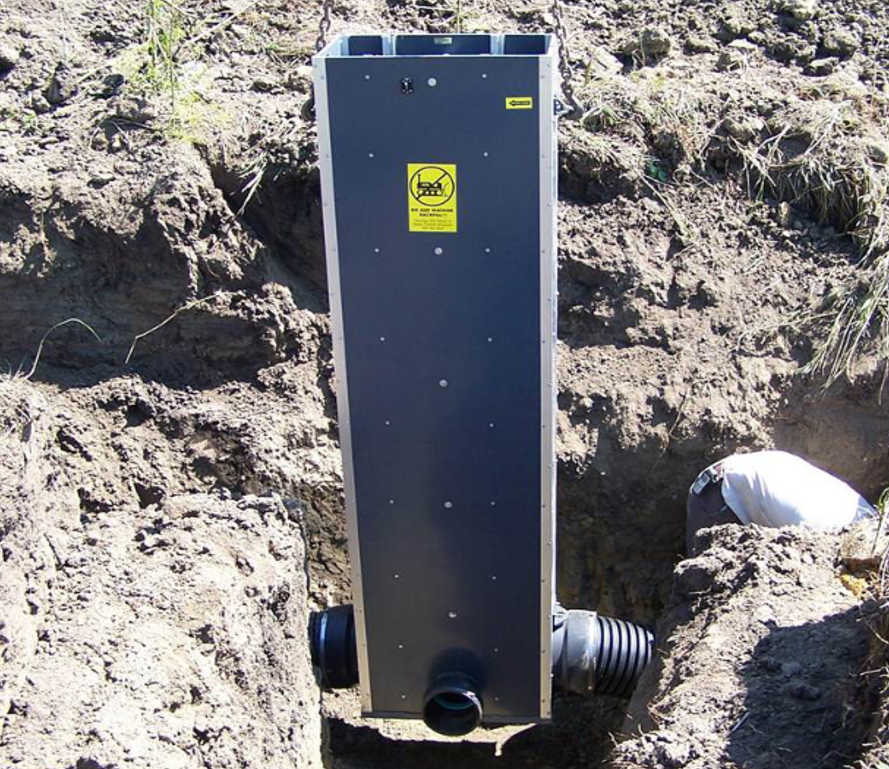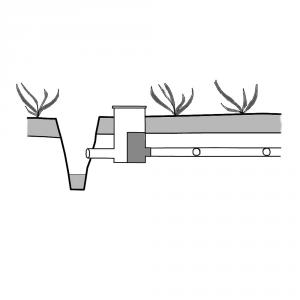Executive Summary
Controlled drainage is a precipitation harvesting method used to reduce short-term water related stress on plants, such as during flooding or drought. With the construction of a water control system, drainage outlets can be artificially set at levels between the surface of the soil and the bottom of the drain. Hence, stored water can be released in water-scarce periods in order to balance out water availability. However, this method cannot supply enough water for longer water-scarce episodes and is therefore unsuitable for dry areas.
| In | Out |
|---|---|
Freshwater, Food Products |
Introduction
Controlled drainage is a method of water harvesting for crop production, manipulating the underground water level. As it can only be applied to level fields (with a slope of maximally 1%), its applicability is strongly limited (BUSMAN & SANDS 2002).
With controlled drainage, water loss can be reduced by between 15 and 35 per cent. As infiltration of water is reduced, fewer nutrients are washed out. Therefore, one main advantage of this system compared to other measures (such as, for example conventional drainage or surface groundwater recharge, subsurface groundwater recharge and other precipitation harvesting measures) is the reduced loss of nitrate (see also the nutrient cycle) (BUSMAN & SANDS 2002). On the other hand, surface runoff is higher, because the soil has less space to hold back water.
Basic design principles
Controlled drainage systems differ from conventional drainage by simple water control structures placed at various locations within the system. The height of the stored water can therefore be manipulated in order to optimise the groundwater level and store infiltrated rain underground for crop production.

Many different designs for controlled drainage systems exist, which can be differentiated between manually or automatically operated structures.
Controlled drainage systems are sensitive to topography and the amount of rainfall, making it important to consider the following limiting factors: for one part, the ground needs to be even with a constant slope of less than 1% (in order to allow accurate control of the water level according to crop root depth). For steeper grounds, this precipitation harvesting method cannot be implemented economically. Instead, other measures such as field trenches, bunds, micro basins and planting pits would be better suited. Furthermore, controlled drainage systems are not useful for very dry areas, as they can only help to reduce short-term related water stress. Longer time periods without rainfall need other rainwater harvesting measures, such as field trenches, bunds, conjunctive use or micro basins.

Cost considerations
Adapted from COOK et al. (2006)
In Illinois (USA), installations of a controlled drainage system lead to average costs of $120 USD per hectare. However, these costs may vary according to the complexity of the topography.
Costs may be lower if already existing drainage systems are converted in order to enable controlled drainage. Due to the existing structure available, lower investments are needed, ranging from $50 to $100 USD per hectare.

Health aspects
Adapted from COOK et al. (2006)
Water quality - and therefore human health conditions - can be improved through controlled drainage systems: as contaminated water is stored in the soil profile over an extended amount of time, its chemical concentration (such as nitrates and other fertilisers or pesticides) is lowered, leading to a decreased wash out into the ground water and therefore higher water quality and better premises for human health.
Operation and Maintenance
Operating a controlled drainage system is complex compared to other rainwater harvesting measures. The main reason is the need for broad knowledge about the best time to raise or lower the water in order to effectively run a drainage system.
At a glance
| Working principle | Controlling the drainage system helps to monitor the groundwater level and influence the amount of water stored or released. |
| Capacity/adequacy | Only applicable to level fields with a slope of less than 1%. |
| Performance | Loss of chemicals (such as nitrates) is reduced in comparison to conventional drainage systems because water is stored in the soil for an extended amount of time. Therefore, groundwater and other receiving water bodies are better protected from pollution by chemicals. |
| Costs | Investment costs are dependent on whether the system has to be newly constructed or only adapted. |
| Self-help compatibility | Expert skills are needed for design and construction; specific skills are needed for operation and maintenance. |
| O&M | The operation of such a system is difficult because good knowledge about the best timing for release or storage of water is needed. |
| Reliability | On-going observation is necessary in order to regulate the water level. |
| Main strength | Short-term water stress can be reduced, leading to increased crop yield. |
| Main weakness | It is difficult to handle such a system most effectively. |
The applicability of controlled drainage systems is limited by two factors: the topography and the amount of rainfall. The ground needs to be even with a constant slope of 1%, at most. If the field is steeper, controlled drainage system cannot be implemented economically. Other water harvesting measures would be more suited. Even though controlled drainage systems can reduce short-term water scarcity, they are not able to overcome longer periods without precipitation and are therefore not suitable for extremely dry areas.
Agricultural Drainage. Issues and Answers
Drainage Water Management. A Practice for Reducing Nitrate Loads from Subsurface Drainage Systems
Drainage Water Management
Review of the Potential for Controlled Drainage Around the World
A project report showing the potential of controlled drainage in around the world with a focus chapter on the Egypt and India. The paper includes influencing factors such as social or water risks as well as crop-related hazards.
ABBOT, C.L., LAWRENCE, P., PEARCE, G.R. and ABDEL-GAWAD, S. (2002): Review of the Potential for Controlled Drainage Around the World. (KAR Project R7133). Oxon: HR Wallingford and Department for International Development (DFID) URL [Accessed: 09.07.2019]Drainage Water Management for the Midwest. Questions and Answers About Drainage Water Management for the Midwest
What is drainage water management? Where is it most suitable? How do I manage it and what is the outcome? This short publication addresses those questions important for practitioners.
FRANKENBERGER, J. KLADIVKO, E. SANDS, G. JAYNES, D. FAUSEY, N. HELMERS, M. COOKE, R. STROCK, J. NELSON, K. BROWN, L. (2006): Drainage Water Management for the Midwest. Questions and Answers About Drainage Water Management for the Midwest. West Lafayette, IN: Purdue Agriculture URL [Accessed: 09.07.2019]Reclaiming Drainage. Toward an Integrated Approach
This report is the concluding document of the study, Agricultural Drainage: Toward an Interdisciplinary and Integrated Approach, under the Bank-Netherlands Partnership Program-Environment/Water Resources Management Window. The study spanned more than two years of literature reviews, field investigations, and analysis. Work included case studies in six countries representing a cross-section of drainage situations in different climatic zones.
SAFWAT, A.D. HOEVENAARS, J. MOLLINGA, P.P. SCHEUMANN, W. SLOOTWEG, R. STEENBERGEN, F. van (2004): Reclaiming Drainage. Toward an Integrated Approach. Washington D.C.: The International Bank for Reconstruction and Development URL [Accessed: 09.07.2019]Effect of Controlled Drainage and Subirrigation on Subsurface Tile Drainage Nitrate Loss and Crop Yield at the Farm Scale
The objectives of the study are to provide on-farm demonstrations of controlled drainage and sub-irrigation systems, and to determine their effect on crop yields and environmental benefits. It compares the nitrate concentration, water loss and crop yields of controlled drainage with free outlet tile drainage.
TAN, C.S. ; DRURY, C.F. ; NG, H.Y.F. ; GAYNOR, J.D. (1999): Effect of Controlled Drainage and Subirrigation on Subsurface Tile Drainage Nitrate Loss and Crop Yield at the Farm Scale. In: Canadian Water Resources Journal : Volume 24 , 177. URL [Accessed: 09.07.2019]Controlled Drainage. A SCIEN Drainage Technology
Powerpoint presentation on controlled drainage, stressing its differences from traditional drainage systems and its impacts, specifically on the nutrient cycle.
BALTIC COMPASS (n.y): Controlled Drainage. A SCIEN Drainage Technology. No Location: Baltic Compass URL [Accessed: 05.09.2012]Controlled Drainage in The Netherlands revisited?
A summary of case studies from the Netherlands evaluating the need for revitalisation of controlled drainage.
Controlled Drainage
A video made by Baltic Compass presenting the advantages of controlled drainage for the Baltic region. The system was tested on a field, measuring the nitrogen and phosphorus concentration of the water runoff.


